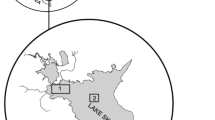Synopsis
The distribution and growth of 0+ Eurasian perch were studied for two years in two shallow lacustrine habitats. Eleutheroembryos were rapidly dispersed from inshore spawning areas to open water. The planktonic larval period was followed by the inshore migration of metamorphosed 0+ perch. Some juveniles remained in shallow water through the summer and all moved offshore in autumn. Growth in length was linear from hatching through the summer but declined and tended to an asymptote from September. Two stanzas were identified for growth in weight, one for the ten days following hatching and the other for the remainder of the first summer. The first stanza coincided with largely endogenous nutrition and limited initial feeding on small zooplankters and the second commenced with intense feeding on zooplankton.
Similar content being viewed by others
References cited
Balon, E.K. 1975. Terminology of intervals in fish development. J. Fish. Res. Board Can. 32: 1663–1670.
Blaxter, J.H.S. 1969. Development: eggs and larvae. pp. 177–252.In: W.S. Hoar & D.S. Randall (ed.) Vol. 3, Fish Physiology, Academic Press, New York.
Černy, K. & K. Pivnička. 1973. Abundance and mortality of the perch fry (Perca fluviatilis, Linnaeus 1758) in the Kličava Reservoir. Věst. Česk. spol. zool. 37: 1–13.
Chapman, D.W. 1967. Production in fish populations. pp. 3–29. In: S.D. Gerking (ed.) The Biological Basis of Freshwater Fish Production, Blackwekk, Oxford.
Coles, T.F. 1981. The distribution of perch,Perca fluviatilis L. throughout their first year of life in Llyn Tegid, North Wales. J. Fish Biol. 18: 15–30.
Coles, T.F., G.N. Swinney & J.W. Jones. 1977. A technique for determining the distribution of pelagic fish larvae. J. Fish Biol. 11: 151–159.
Einarsson, H. 1960. The fry ofSebastes in Icelandic waters and adjacent seas. Rit. Fiskideildar 1: 1–64.
Forney, J.L. 1971. Development of dominant year classes in a yellow perch population. Trans. Amer. Fish. Soc. 100: 739–749.
Guma’a, S.A. 1978a. The food and feeding habits of young perch,Perca fluviatilis, in Windermere. Freshwat. Biol. 8: 177–187.
Guma’a, S.A. 1978b. On the early growth of 0+ perch,Perca fluviatilis, in Windermere. Freshwat. Biol. 8: 213–220.
Henderson, M.A. 1977. Growth, mortality, production and feeding of yellow perch fry,Perca fluviatilis flavescens (Mitchill) and their effect on theDaphnia pulicaria Forbes of West Blue Lake. M.Sc. Thesis, University of Manitoba, Winnipeg. 135 pp.
Houde, E.D. 1969. Distribution of larval walleyes and yellow perch in a bay of Oneida Lake and its relation to water currents and zooplankton. N.Y. Fish Game J. 16: 184–205.
Kuznetsov, V.A. 1972. The growth pattern of larvae and young of some freshwater fish at different stages of development. J. Ichthyol. 12: 433–442.
Lin, Y.S. 1975. Food and growth of young yellow perch during the pelagic and demersal stages in Oneida Lake. Ph.D. Thesis, Cornell University, Ithaca. 96 pp.
Mills, E.L. & J.L. Forney. 1981. Energetics, food consumption, and growth of young yellow perch in Oneida Lake, New York. Trans. Amer. Fish. Soc. 110: 479–488.
Nellen, W. & D. Schnack. 1974. Sampling problems and methods of fish eggs and larvae investigations with special reference to inland waters.In: EIFAC Symposium on Methodology for the Survey, Monitoring and Appraisal of Fishery Resources in Lakes and Large Rivers. Aviemore, Scotland. Contribution No. 57.
Noble, R.L. 1968. Mortality rates of pelagic fry of the yellow perch,Perca flavescens (Mitchill), in Oneida Lake, New York, and an analysis of the sampling problem. Ph.D. Thesis, Cornell University, Ithaca. 104 pp.
Noble, R.L. 1970. Evaluation of the Miller high-speed sampler for sampling yellow perch and walleye fry. J. Fish. Res. Board Can. 27: 1033–1044.
Noble, R.L. 1975. Growth of young yellow perch (Perca flavescens) in relation to zooplankton populations. Trans. Amer. Fish. Soc. 104: 731–741.
Tarby, M.J. 1974. Characteristics of yellow perch cannibalism in Oneida Lake and the relation to first year survival. Trans. Amer. Fish. Soc. 103: 462–471.
Treasurer, J.W. 1983. Estimates of egg and viable embryo production in a lacustrine perch,Perca fluviatilis. Env. Biol. Fish. 8: 3–16.
Author information
Authors and Affiliations
Rights and permissions
About this article
Cite this article
Treasurer, J.W. The distribution and growth of lacustrine 0+ perch,Perca fluviatilis . Environ Biol Fish 21, 37–44 (1988). https://doi.org/10.1007/BF02984441
Received:
Accepted:
Issue Date:
DOI: https://doi.org/10.1007/BF02984441




